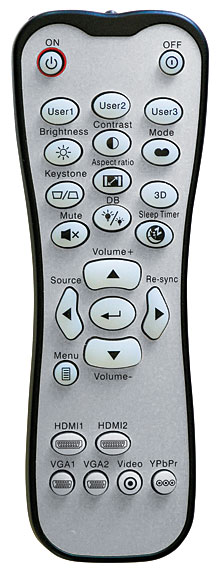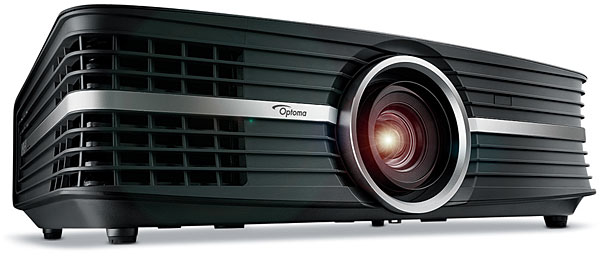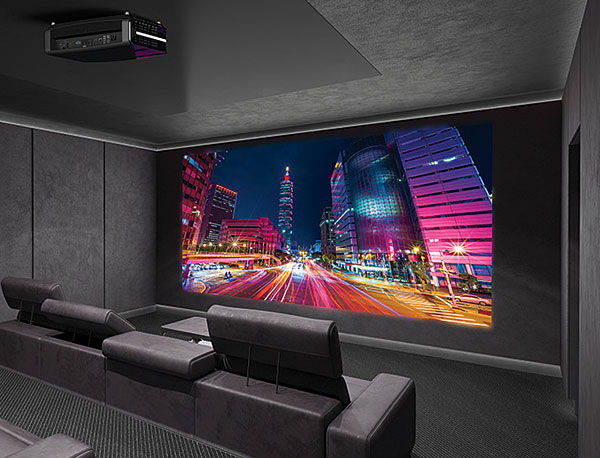The UHD65 falls short on three counts.
No 3D is a huge downfall.
Poor black levels, and so-so contrast negate the detailed picture quality that the UHD65 produces with 4k source material.
A much better option is the Epson UB5040. Its shift based technology reproduces very good faux 4k, along with excellent 3D. It has a fantastic lens and a boat full of great features.
For those who are in the market for a true 4k projector the only somewhat affordable option is the new Sony VW285ES.
Unfortunately at $5,000 is double the price of the Optoma and the Epson (both at $2,500).
Optoma UHD65 4K DLP Projector Review Page 2
Even before I adjusted the color calibration controls, the projector’s strengths and weaknesses were clearly evident. On the downside, its black level won’t win any prizes. It was uninspiring (if no worse than what you’d experience in your local multiplex).Full screen fades between scenes dropped to a medium gray, rather than the very dark gray the best projectors offer—not to mention the total black of an OLED TV. This troubled me less than it should have, because the UHD65’s performance on medium dark scenes with bright highlights (we’re still talking standard dynamic range here) was reasonably satisfying. It also helped that I did my viewing ona 96-inch-wide, 2.35:1 Stewart Filmscreen StudioTek 130 (gain 1.3), which hid the gray-black bars that otherwise would have been very distracting on letterboxed films.
 It was only when I turned to truly dark material—the caves in Prometheus or more than a few scenes in Harry Potter and the Deathly Hallows: Part 2—that I missed the black leveland contrast on my regu-
lar 1080p JVC DLA-X35 projector (not new, 4K, or even faux-K). Calibration did nothing to improve the Optoma’s blacks; once the basic controls are set with reasonable care and the room is darkened, black level is a function of fac-
tors beyond any user adjustments.
It was only when I turned to truly dark material—the caves in Prometheus or more than a few scenes in Harry Potter and the Deathly Hallows: Part 2—that I missed the black leveland contrast on my regu-
lar 1080p JVC DLA-X35 projector (not new, 4K, or even faux-K). Calibration did nothing to improve the Optoma’s blacks; once the basic controls are set with reasonable care and the room is darkened, black level is a function of fac-
tors beyond any user adjustments.
That said, in other respects, the Optoma produced HD/SDR images that were good—and sometimes, they were exceptional. At a peak brightness level of just under 20 foot-lamberts, colors were excellent. There was some occasionally overripe saturation in fleshtones, but minor reductions in the Color control helped tame this. (Besides, it’s often a source issue, particularly in the creative use of color in many films.) The mild sepia tint in Their Finest (a small gem of a British dramedy about the making of an inspirational Dunkirkmovie just after the 1940 evacuation) came through perfectly. A few scenes from the movie withinthe movie were also interesting, as they undoubtedly were produced to simulate the early Technicolor ofthe period—and possibly two-strip Technicolor at that.
Overall, my viewing of HD/SDR material on the UHD65 was a pleasure (apart from those black levels). Even 1080p material, as upconverted to the higher resolu- tion of the new TI chip, could look startlingly detailed. Every pore and bead of sweat on Tom Hanks’ facein Sully was clearly visible. Not allof the material I watched was quite that crisp, but if the detail was in the source, the Optoma put it on the screen.
In Use: UHD/HDR
High dynamic range for projection remains something of an oxymoron. Most home HDR sources are mastered to a peak brightness of 1,000 nits (though a few go as high as 4,000). Projectors typically can’t go anywhere near this bright. Post-
calibration, the UHD65 maxedout at 100 nits, a decent result for a projector, particularly one in its price range. Flat-screen TVs can approach 700 nits for OLEDs and go as highas a bit over 1,500 nits for the best LCD/LED designs. When the source exceeds the capability of the dis-
play, the latter must “tone map” the material to match. How well it does this can be unpredictable, thoughit should be straightforward, as consumer TV manufacturers are sometimes creative in how theytone map (rather than adhering toa standard).
The UHD65 has the same black- level limitations in HDR as in SDR. And it didn’t measure as well in HDR in other respects, either, largely because of its limitation in peak brightness and in how it choosesto follow the HDR gamma curve or EOTF, the latter trickier to achieve in practice than SDR’s gamma curve.

In addition, there are as yet no consumer displays of any type that can do full Rec. 2020 color (the ultimate goal of advanced colorfor UHD). The color gamut used currently on any Ultra HD Blu-ray (at present, the best consumer UHD/HDR source) is Rec. 2020 derived from the P3 digital cinema standard; essentially a P3-sized package inside a big Rec. 2020 envelope. Some displays can fully reproduce all the color on a UHD disc, but the UHD65 (and many other displays as well) can’t quite get there. (In any event, you should take with a grain of salt any claim or measurement showing that a display reaches, for example, 90 percent of P3 values. Does it mean that it achieves that percent- age in all primary and secondary colors, and at all luminance levels? Probably not.)
With just 100 nits in the tank, the Optoma doesn’t scream High Dynamic Range. Neither will most other projectors—particularly ones that are affordable. But while both the color and the HDR experiences are more subdued here than what you’ll see from a premier flat-screen UHDTV, you’ll definitely see more pop in the contrast and more vivid colors here compared with the same material in HD/SDR on this projector. As for resolution, unless you sit close enough to a flat-screen set to see all the detail offered by 4K—about 6.5 feet is optimum for most common screen sizes—it won’t match the resolution you’ll see from a true 4K projector on a 110-inch-diagonal screen viewed from 11 feet. The pixel-shifted Optoma, which puts all of the 4K pixels on the screen (though not at the exact same time), should be com- parable in this distance game.
After calibration, the best UHD/HDR material looked stunning. The Great Wall may not be a great film (an understatement), but it’s pure eye- and ear-candy for the home theater enthusiast. As reportedly mastered from a 4K digital intermediate, the brilliantly colored uniforms—many of them with intricately detailed armor—were jaw dropping. Highlights were well rendered for a projector. And the film appears to have been carefully crafted to avoid dark scenes with very low contrast (there’s even a brief shot here that was clearly done day-for-night). With this film, moreso than any other I viewed, I wasn’t bothered by the projector’s inherently poor contrast.
Guardians of the Galaxy: Vol. 2 was another UHD/HDR standout. (It, too, was reportedly transferred, at least in part, from a 4K digital intermediate. Do we see a trend here?) The whole film is an uninterrupted riot of rich, saturated color and crisp detail, even more so than The Great Wall. While I have no idea of what’s going on in the final 20 minutes (something about Peter Quill trying to kill off his God-Father while a planet collapses around him), on the Optoma it was a feast of 4K resolution and sparkling color, together with lim- ited but rewarding HDR.

Not every UHD/HDR Blu-ray worked as well (and all of the material used here was on disc; I don’t trust the quality of streamed UHD video). Independence Day was often soft-looking, with one particularly egregious shift to red fleshtones at 10:29, as Lucas complains about his fields not being crop-dusted properly. On the other hand, Independence Day: Resurgence (which makes The Great Wall look like Citizen Kane) was solid on the Optoma.
I did occasionally notice too-reddish fleshtones elsewhere as well. Whether this was a creative choice, a mastering problem, or an issue with the projector was hard to pin down, but I have also seen it from time to time on flat-screen HDR sets. Since the color calibration on the Optoma was a little skewed by ideal standards, that might have beena factor. The cure, which usually(but not always) worked, was aslight reduction in the Color control. Of course, if the red tone wasa creative decision by the filmmakers, you’re on your own with such alterations. The video police won’t come knocking—at least, I don’t think so.
One other issue raised its head: color banding. I saw this on more than one disc in large areas of color, such as the red sky in The Martian. But it wasn’t everywhere. Often, I looked for it in areas where I expected to see it, but it didn’t appear. It was infrequent enough not to draw me out of the film, but other viewers might not be so tolerant.
Conclusions
It’s hard to judge the Top Pick–worthiness of a product with a unique feature set. I’ve reviewed many projectors, butthis is the first HDR-capable model I’ve tested that lists for $2,500. I can judge contrast, however, and the Optoma isa bit too business-
model-ish in that regard to make me perfectly happy withit on all sorts of material, particularly a wide range of movies. Still, the UHD65 did impress me in other respects—enough for me to recommend a serious audition. Just be sure to bring Harry Potter (or your own black-level torture test) along with you.
- Log in or register to post comments
























































